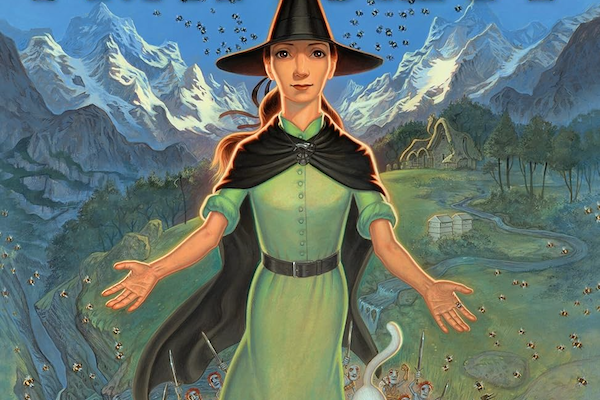The cover says it’s a picture book for “people of all sizes,” and I wish there were more of those, honestly.
Summary
We are reading Where’s My Cow? through the vantage point of Young Sam and his father (less young Sam). The story begins with the similar framing we’re given in Thud! explaining that Sam Vimes is sure to be home at six o’clock every evening to read Sam his book. Sam Vimes reads the book, and we’re told how well he does the various noises for all the animals—a lovely bit of meta-commentary within the story itself.
But Vimes knows that the story is silly, and tells Young Sam that the subject of the book should report their lost cow to the City Watch. He thinks there should be a different version of the book that more accurately reflects his son’s experiences in the city where he’s growing up—not the country that he’s never seen. The very next night, he makes up a new version of book, about the reader looking for his father. He meets all sorts of strange folk though the city and learns their funny catchphrases. Suddenly, Sybil enters the room, wanting to be sure that Vimes isn’t getting Young Sam too excited. Sam pretends to go back to the regular version of the text.
When Sybil has gone, Vimes finishes the story with the subject of the tale finding his daddy, who arrests people in the name of the law. Then he tucks Young Sam in and bids him goodnight.
Commentary
The picture book version of Where’s My Cow? is illustrated by Melvyn Grant, and it’s those illustrations that really make the whole exercise worth it. There are three distinct styles at play within the artwork: the illustrations from the original book itself, which are simple line drawings; the world outside, which is rendered more realistically, but also drab in color; and Sam’s nursery, which is also rendered in a realistic fashion, but full of color and light and anthropomorphized movement of inanimate objects. By the end of the story, all these styles combine on each page in an avalanche of movement and silliness.
There’s the additional enjoyment of seeing various Discworld characters so fully rendered: Vetinari, Dibbler, Detritus, and so on. (And Sybil, my beloved, with her looming figure, so commanding and affectionate at the same time.) You can even see Gaspode with Foul Ole Ron. And then there’s the meta-fun of seeing the cover of the book inside the book itself as you’re reading the book. So you are being made into the snake eating its own tail, as it were. You’re participating in circle.
Buy the Book


Where’s My Cow?
The movement within Sam’s nursery is perfectly indicative of the imagination of childhood and how alive our surroundings can seem when we’re very young and imbue anything with a personality. We’ve got a family dragon following them around, but Sam’s toys are alive, and so are his books, and all the furniture as well. Even the paint on the walls comes to life. On the last page, we can see that Sam’s toys are going to sleep along with him—but that painting with the flowers above his crib is still looking awfully three-dimensional, popping out of its frame. Probably because that’s always how Sam perceives it.
Vimes is very clearly based on Pete Postlethwaite, which Pratchett always insisted was the Sam Vimes in his head. Grant gets a lot of mileage out of that by both being a great illustrator and having a great subject. Postlethwaite was a very expressive fellow, after all.
Ultimately, however, this is a book about exactly what Vimes would want it to be about: a father enjoying time with his son. Every page is plastered with images of them together, having fun and making each other laugh. Because some things are important, as he says. And if you happen to read it to your own kids (or share it with people you care for), you can participate in that ritual as well.
Asides and little thoughts:
- Melvyn Grant has done illustrations for plenty of books, but his most interesting credits are definitely his Iron Maiden album covers. He did five of them, including Fear of the Dark.
- There’s an illustration of Pratchett on the wall of Sam’s nursery (you can see him on the last page), which would make him one of Sybil’s relatives presumably within the story? I wonder which one…
- Okay, but I posit that if Pete Postlethwaite was the person Pratchett envisioned for Vimes and he is no longer with us, the logical successor to that mantle is Christopher Eccleston. (It’s difficult because they’re both too tall to my mind, but Eccleston is still the right fit from Postlethwaite.)
Pratchettisms:
“Your cow will be found. If if has been impersonating other animals, it may be arrested. It you are a stupid person, do not look for your cow yourself. Never try to milk a chicken. It hardly ever works.”
Next week we’ll start Making Money! We’ll read Chapters 1-3.













